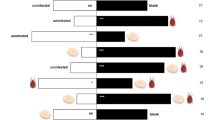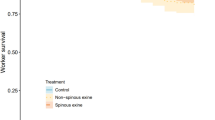Abstract
The performance of Tetranychus urticae and its predator Neoseiulus californicus on ten strawberry cultivars was determined in the laboratory. Development time and survival of T. urticae from egg to adult were recorded on Albión, Aromas, Camarosa, Diamante, Festival, Kp, Sabrosa, Selva, Sweet Charlie, and Whitney. Fecundity of newly molted and mated females was recorded during the first 10 days of oviposition. Predation rate and fecundity of N. californicus were tested on Albión, Aromas, Festival, Kp, Sabrosa, and Whitney. Predator females reared on each cultivar were placed individually in experimental units, and the number of eggs per day was counted during 3 days. Cultivars with high hairiness (Albión, Aromas, and Festival) and cultivars with low hairiness (Sabrosa, Whitney and Kp) were identified, to assess the effect on the performance of both species. Development time, survival from egg to adult, and fecundity of T. urticae differed among cultivars. Festival was classified as moderately resistant, Aromas and Kp were moderately susceptible, and the others were intermediate. The number of prey consumed per day per female of N. californicus differed between cultivars and time. Fecundity of N. californicus did not differ among cultivars; however, it did over time. The development time and fecundity of T. urticae did not differ among high and low hairiness cultivars. The glandular hairiness affected neither consumption nor fecundity of N. californicus. According to detrimental and propitious effect on T. urticae and N. californicus performance, respectively, we concluded that Festival and Albión could be used along with this predator in T. urticae management programs.








Similar content being viewed by others
References
Afzal M, Bashir MH (2007) Influence of certain leaf characters of some summer vegetables with incidence of predatory mites of the family Cunaxidae. Pak J Bot 39(1):205–209
Agrawal AA (2000) Host range evolution: adaptation of mites and trade-offs in fitness on alternate hosts. Ecology 81:500–508
Ahn JJ, Kim KW, Lee JH (2010) Functional response of Neoseiulus californicus (Acari:Phytoseiidae) to Tetranychus urticae (Acari: Tetranychidae) on strawberry leaves. J Appl Entomol 134:98–104
Boethel DJ, Eikenbary RD (eds) (1986) Interactions of plant resistance and parasitoids and predators of insects. Ellis Horwood, Chichester
Bottrell DG, Barbosa P (1998) Manipulating natural enemies by plant selection and modification: a realistic strategy? Ann Rev Entomol 43:347–367
Cédola CV, Sánchez NE, Liljesthröm GG (2001) Effect of tomato leaf hairiness on functional and numerical response of Neoseiulus californicus (Acari:Phytoseiidae). Exp Appl Acarol 25:819–831
Duso C (1992) Role of Amblyseius aberrans (Oud.), Typhlodromuns pyri Scheuten and Amblyseius andersoni (Chant) (Acari, Phytoseiidae) in vineyards. J Appl Entomol 114:455–462
Eigenbrode SD, Castagnola T, Roux MB, Steljes L (1996) Mobility of three generalist predators is greater on cabbage with glossy leaf wax that on cabbage with a waxy bloom. Entomol Exp Appl 81:335–343
El-Shafei GMA, Gotoh T (2010) Performance of eighteen tetranychid mite species (Acari: Tetranychidae) on borage and strawberry. Appl Entomol Zool 45:579–585
Gehan EA, Thomas DG (1969) The performance of some two sample tests in small samples with and without censoring. Biometrika 56:127–132
Giménez Ferrer RM, Scheerens JC, Erb WA (1993) In vitro screening of 76 strawberry cultivars for twospotted spider mite resistance. HortScience 28:841–844
Giménez-Ferrer RM, Erb WA, Bishop BL, Scheerens JC (1994) Host-pest relationships between the twospotted spider mite (Acari: Tetranychidae) and strawberry cultivars with differing levels of resistance. J Econ Entomol 87:168–175
Gontijo LM, Margolies DC, Nechols JR, Cloyd RA (2010) Plant architecture, prey distribution and predator release strategy interact to affect foraging efficiency of the predatory mite Phytoseiulus persimilis (Acari:Phytoseiidae) on cucumber. Biol Control 53:36–141
Gould F, Kennedy GG, Johnson MT (1991) Effects of natural enemies on the rate of herbivore adaptation to resistant host plants. Entomol Exp Appl 58:1–14
Greco NM, Sánchez N (2003) Effects of previously damaged strawberry plants on Tetranychus urticae Koch (Acari: Tetranychidae). Acarologia 43(1):59–65
Greco NM, Sarandón SJ, Pereyra PC (1998) Parasitism of Diatraea saccharalis (Lepidoptera: Pyralidae) eggs by Trichogramma exiguum (Hymenoptera: Trichogrammatidae): influence of Zea mays leaf pubescence. Ecología Austral 8:31–35
Greco NM, Pereyra PC, Guillade A (2006) Host-plant acceptance and performance of Tetranychus urticae (Acari, Tetranychidae). J Appl Entomol 130(1):32–36
Hare JD (1992) Effects of plant variation on herbivore-natural enemy interactions. In: Fritz RS, Simms EL (eds) Plant resistance to herbivores and pathogens ecology evolution and genetic. University of Chicago Press, Chicago
Harvey TL, Martin TJ (1980) Effects of wheat pubescence on infestations of wheat curl mite and incidence of wheat streak mosaic. J Econ Entomol 73:225–227
Kaplan EL, Meier P (1958) Nonparametric estimation for incomplete observation. J Am Stat Assoc 53:457–481
Karban R, English-Loeb G, Walker MA, Thaler J (1995) Abundance of phytoseiid mites on Vitis species: effects of leaf hairs, domatia, prey abundance and plant phylogeny. Exp Appl Acarol 19:189–197
Kazak C, Kibritçi C (2008) Population parameters of Tetranychus cinnabarinus Boisduval (Prostigmata: Tetranychidae) on eight strawberry cultivars. Turk J Agric For 32:19–27
Khan SM (2011) Varietal performance and chemical control used as tactics against sucking insect pest of cotton. Sarhad J Agric 27:255–261
Klingen I, Westrum K (2007) The effect of pesticides used in strawberries on the phytophagous mite Tetranychus urticae (Acari: Tetranychidae) and its fungal natural enemy Neozygites floridana (Zygomycetes: Entomophthorales). Biol Control 43:222–230
Krips OE, Witul A, Willems PEL, Dicke M (1998) Intrinsic rate of population increase of the spider mite Tetranychus urticae on the ornamental crop gerbera: intraspecific variation in host plant and herbivore. Entomol Exp Appl 89:159–168
Krips OE, Willems PEL, Dicke M (1999) Compatibility of host plant resistance and biological control of the Two-Spotted spider mite Tetranychus urticae in the ornamental crop gerbera. Biol Control 16:155–163
Labanowska BH (2007) Susceptibility of strawberry cultivars to the two-spotted spider (Tetranychus urticae Koch). J Fruit Ornam Plant Res 15:133–146
Levin DA (1973) The role of trichomes in plant defense. Q Rev Biol 48:3–15
Lourençao AL, Moraes GJ, Passos FA, Ambrosano GMB, Lásaro E, Silva VF (2000) Resistência de Morangueiros a Tetranychus urticae Koch (Acari: Tetranychidae). An Soc Entomol Bras 29(2):339–346
Luczynski A, Isman MB, Raworth DA, Chan CK (1990) Chemical and morphological factors of resistance against the twospotted spider mite in beach strawberry. J Econ Entomol 83:564–569
O’Brien TP, Mc Cully ME (1981) The study of plant structure. Principles and selected methods. Termacarphy Pty. Ltd., Melbourne
Oku K, Yano S, Takafuji A (2006) Host plant acceptance by the phytophagous mite Tetranychus kanzawai Kishida is affected by the availability of a refuge on the leaf surface. Ecol Res 21:446–452
Onyambus GK, Maranga RO, Gitonga LM, Knapp M (2011) Host plant resistance among tomato accessions to the spider mite Tetranychus evansi in Kenya. Exp Appl Acarol 54:385–393
Petrova V, Cudare Z, Steinite I, Laugale V (2000) Preliminary studies on resistance of some strawberry cultivars to spider mite Tetranychus urticae. IOBC WPRS Bull 23:119–122
Price PW (1986) Ecological aspects of host plant resistance and biological control: interactions among three trophic levels. In: Boethel DJ, Eikenbary RD (eds) Interactions of plant resistance and parasitoids and predators of insects. Ellis Horwood, Chichester, pp 11–30
Rodríguez JG, Rodríguez LD (1987) Nutritional ecology of phytophagous mites. In: Slansky F, Rodríguez J (eds) Nutritional ecology of insects, mites, spiders and related invertebrates. Wiley, New York, pp 177–208
Sabelis MW (1985) Reproductive strategies. In: Helle W, Sabelis MW (eds) Spider mites. Their biology, natural enemies and control, vol 1A. Elsevier, Amsterdam, pp 265–278
Scheiner SM, Gurevitch J (2001) Design and analysis of ecological experiments. Oxford University Press, Oxford
Shanks CH Jr, Moore PP (1995) Resistance to twospotted spider mite and strawberry aphid in Fragaria chiloensis, F. virginiana, and F. × ananassa clones. HortScience 30:596–599
Shanks CH Jr, Chandler CK, Show ED, Moore PP (1995) Fragaria resistance to spider mites at three locations in the United States. HortScience 30(5):1068–1069
Skorupska A (2004) Resistance of apple cultivar to two-spotted spider mites, Tetranychus urticae (Acarina: Tetranychidae). Part II. Influence of leaf pubescence of selected apple cultivars on fecundity of two-spotted spider mites. J Plant Prot Res 44:69–74
Steinite I, Ievinsh G (2002) Wound-induced responses in leaves of strawberry cultivars differing in susceptibility to spider mite. J Plant Physiol 159:491–497
Steinite I, Ievinsh G (2003) Possible role of trichomes in resistance of strawberry cultivars against spider mite. Acta Univ Latviensis Ser Biol 662:59–65
Torre Figueiredo AS, Vilela Resende JT, Ferreira Morales RG, Santos Gonçalves AP, Da Silva PR (2012) The role of glandular and non-glandular trichomes in the negative interactions between strawberry cultivars and spider mite. Arthropod-Plant Interact 7:53–58
Uselis N, Valiuskaite A, Raudonis L (2006) Incidence of fungal leaf diseases and phytophagous mites in different strawberry cultivars. Agron Res 4:421–425
Vet LEM, Dicke M (1992) Ecology of infochemical use by natural enemies in a tritrophic context. Annu Rev Entomol 37:141–172
Webster JA (1975). Association of plant hairs and insect resistance. Miscellaneous publication. Nº 1297. Agriculture Research Service, US Department of Agriculture
Wold SJ, Hutchison WD (2003) Varietal resistance to Tetranychus urticae Koch (Acari: Tetranychidae) in Minnesota strawberries and control with bifenthrin. J Entomol Sci 38:692–695
Xu J, Lin KK, Liu SS (2011) Performance on different host plants of an alien and an indigenous Bemisia tabaci from China. J Appl Entomol 135(10):771–779
Yano S, Wakabayashi M, Takabayashi J, Takafuji A (1998) Factors determining the host plant range the phytophagous mite, Tetranychus urticae (Acari: Tetranychidae): method for quantifying host plant acceptance. Exp Appl Acarol 22:595–601
Zar HJ (1996) Biostatistical analysis. Prentice-Hall, New Jersey
Author information
Authors and Affiliations
Corresponding author
Additional information
Handling Editor: Guy Smagghe.
Rights and permissions
About this article
Cite this article
Gugole Ottaviano, M.F., Sánchez, N.E., Roggiero, M.F. et al. Performance of Tetranychus urticae and Neoseiulus californicus on strawberry cultivars and assessment of the effect of glandular trichomes. Arthropod-Plant Interactions 7, 547–554 (2013). https://doi.org/10.1007/s11829-013-9268-x
Received:
Accepted:
Published:
Issue Date:
DOI: https://doi.org/10.1007/s11829-013-9268-x




